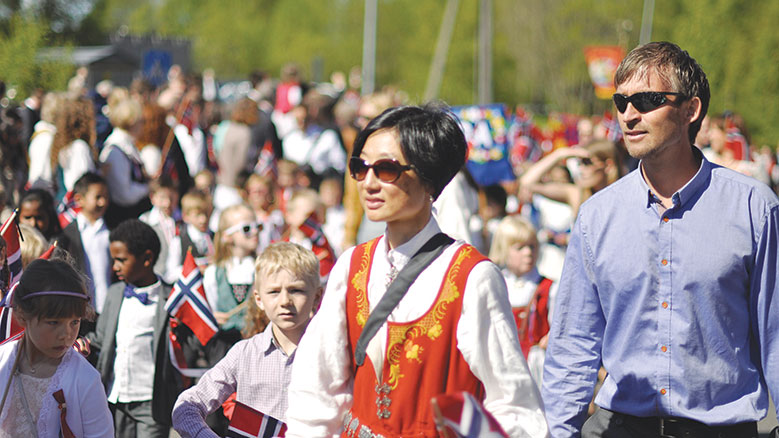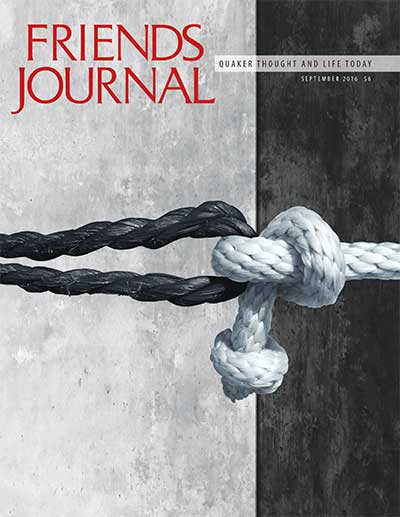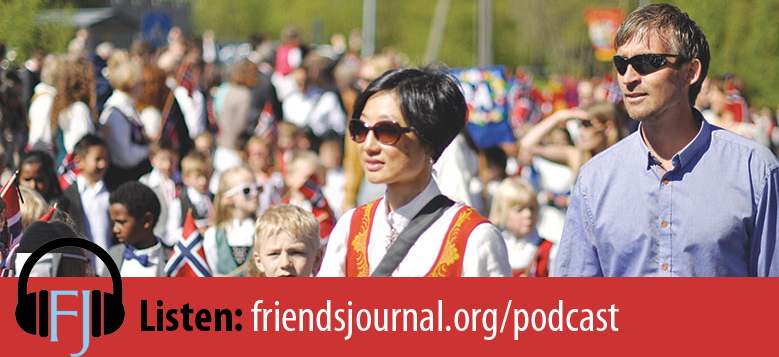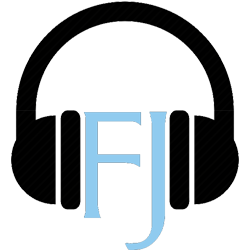
FJ PODCAST SUBSCRIPTION: ITUNES | DOWNLOAD | RSS | STITCHER
When I was a young adult getting to know Friends, one of the testimonies that most surprised and intrigued me was equality. My home church had been comfortable with hierarchy. The Quakers I met dressed simply and told me stories about early Friends who’d been jailed for not showing sufficient respect to “their betters.”
Soon after discovering Friends, I joined an American Friends Service Committee summer project where I fell in love with Berit Mathiesen, a Norwegian. I moved to her country, acquiring a family of in-laws, a second language, and another people that valued equality.
As I experienced Berit’s culture, I remembered another bit of Friends history I’d heard at West Chester (Pa.) Meeting. When early Quaker shopkeepers marked set prices on their goods, violating the prevailing business practice of haggling over prices, more customers came to them. Prosperity, it turned out, accompanied Friends’ perception of the ethical thing to do. I learned that lesson again in Norwegian practices I observed.
When I registered as a student at the University of Oslo, for example, I put down my $14 matriculation fee and double-checked to see if I had really paid in full. I turned to another student and asked, “How does it make any sense that Norway offers free higher education?”
“Look,” Sigurd said, “wouldn’t you say, George, that brains are an economic resource to a country?”
“Well, yes, of course.”
“Then,” he continued, “why wouldn’t a country want to develop its resources fully instead of letting a barrier like money get in the way?”
As I walked home, I kept shaking my head at the sheer practicality of it. Yes, it represented a bold commitment to the value of equality to make higher education free, but Sigurd’s argument was clearly correct: a nation fully tapping its economic resources is likely to become more prosperous. As those early Quaker merchants found, faith and practical outcome were in agreement.
When in 2008 to 2009 Americans’ confidence was shaken by the specter of financial collapse, I became more curious about the practical egalitarians across the sea. Now supported by my professorship at Swarthmore College, I took the time to study what the Nordics had been up to, not only the Norwegians whose prosperity could be discounted by their discovery of oil, but also others without oil but with a similar culture: Denmark, Sweden, and Iceland. I interviewed economists and others, calling my study “Viking Economics.” What I learned affirms the practical value of boldly implementing equality.
John Woolman tries “work–life balance”
John Woolman was a sought-after tailor in eighteenth-century Mount Holly, New Jersey, and began to worry that his occupation was outstripping his ability to be faithful to his concern for equality for indigenous peoples and enslaved Africans. He deliberately cut back on his tailoring job. These days many of us also struggle with how to apportion our time.
The modern Vikings agree with Woolman in his concern for balance. In Denmark, for example, the average number of hours worked per year is 1,430, compared with 1,790 in the United States. That comparison was from 2012, and I’m told the gap between the Vikings and us has increased since then.
Work–life balance is connected to equality. Longer hours are characteristic of less equal countries, where people do as much as two months’ extra work a year. We might assume that cutting hours means cutting output, but Norwegian workers are far more productive per hour than U.S. workers. The Nordic countries also have a higher percentage of their populations in paid occupations than the United States does. They restructured their economies so they can work hard, get a lot done, quit early, and devote themselves to family, hobbies, activism, and community, including voluntary service.
When babies come along, families are offered paid parental leave. Danish parents, for example, get 52 weeks of paid parental leave. Norwegians found that dads were often letting the mom take all the leave, which for people in competitive career lines meant that women fell behind in advancement and total life earnings. Inequality—outrageous! So Norwegians were the first in the world to incentivize dads to take more responsibility for their children, by setting aside part of the parental time for the dad; if he doesn’t take it, the couple cannot transfer the time to the mom. “Use it or lose it” was the motto. Now nearly all fathers use their quota.
The Nordics are understandably proud of their single-payer healthcare system, which cuts waste and costs less per capita than the United States spends, and yet covers every individual. This and many other policies—universally applied, not welfare-based—make the Nordic countries among the best places in the world to rear children, find a rewarding job, and be a retired person.
It’s a mistake, though, to think that these outcomes somehow arose inevitably from an egalitarian cultural DNA. A century ago a majority of Icelanders and their Viking cousins were poor. The wealth gap was huge. A majority wanted change, but their situation was analogous to the U.S. situation discovered by the famous 2014 Princeton “oligarchy” study, in which political scientists found that the policy preferences of the majority of Americans are routinely frustrated by the economic elite. A century ago the Nordics had fairly free elections, as we do now, but the direction of their economy was in fact set by their 1 percent.
In each of the Nordic countries, the people who believed in equality decided to wage nonviolent campaigns for justice. They won some campaigns and lost others, but overall their movements over time generated a power shift away from the dominance of their economic elites. In the 1930s the Swedish and Norwegian movements opened the space to aim for equality. They joined with the Danes who started earlier to build what we now call “the Nordic economic model.”
All four countries found it possible to generate more equality and enjoy more individual freedom than we and British Friends experience. The Nordic model is synergistic; the whole is greater than the sum of its parts. Building that model enabled the Nordics to virtually abolish poverty and sustain a track record of shared prosperity. They took a historic step forward for the testimony of equality.
Defending equality: the Icelandic experience
While doing training work for New Zealand Quakers in the early 1970s, I happened to coincide in Wellington with a governmental consultation with the International Monetary Fund. I learned that the IMF was urging New Zealand to drop its full-employment policy and generate unemployment, in order to become more attractive to international investors.
In the early years of this century, Iceland departed from the Nordic model. Their bankers went wild. Iceland’s financial sector imploded in 2008—one of the worst financial collapses in history. In desperation, the government appealed to the IMF for help. Some things don’t change: the IMF’s help was conditional on increasing unemployment.
Three percent of Icelanders went to the streets, using nonviolent direct action to force out the governing coalition and bring in the parties committed to equality. (In the United States, the equivalent proportion of people on the streets would be ten million.)
Backed up by the grassroots uprising, the new Icelandic government was able to negotiate an equality-oriented deal rather than the IMF’s usual recipe. As a result, Iceland bounced back quicker than countries that swallowed the conventional austerity prescription, including the United States.
As I listened to Icelanders’ stories about the conflict between their deep commitment to equality and what the IMF mistakenly believed was the pragmatic thing to do, I heard another affirmation of the recurrent Quaker breakthrough. The testimony of equality is both right and realistic. Since 2008 the track record speaks for itself: the income gap of most countries grew, while Icelanders’ incomes became closer to equal.
It seems that Friends have often been right to challenge the worldly version of “realism” in order to remain faithful to their testimonies. The integrity of means and ends is embedded in the very nature of this world, even though our limited understanding may raise doubts. In his earthy way, Jesus asked, “Do people pick grapes from thornbushes, or figs from thistles?” (Matthew 7:16, New Living Translation).
The best practices of the Nordics can give us confidence. If we believe in equality, surely it is time once again for Friends to be bold.






I greatly enjoyed George Lakey’s article “Equality Among Today’s Vikings”. While he described the current emphasis on equality in the Nordic (Viking) countries, it is also interesting that there is a strong link between early Friends and Viking culture.
In “Albion’s Seed: Four British Folkways in America”, David Hackett Fisher notes that the Northern Midlands in England, the birthplace of Quakerism, was more densely settled by Norse invaders then any other part of England. One of the Scandinavian folkways that the Norse brought with them to that part of England was that woman had high social status and enjoyed full legal protection. It is somewhat ironic that the Quaker religious belief “in soul there is no sex” was likely influenced by a regional culture that awarded woman rights and status out of a past necessity arising from the long absences of men away on voyages of plunder.